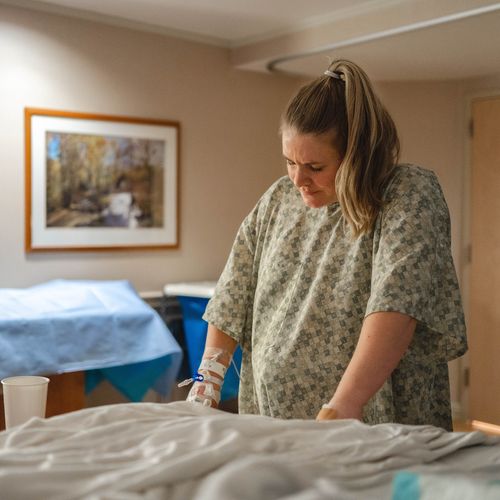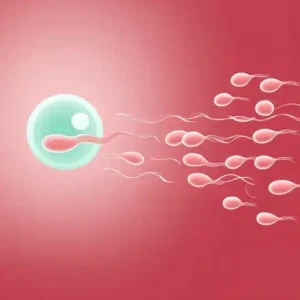Braxton Hicks contractions, also known as false labour pains, are a common occurrence for many women during pregnancy. Understanding what causes these contractions and how to ease any discomfort is key. This blog provides everything pregnant women need to know about Braxton Hicks.
Braxton Hicks contractions are tightenings of the womb that come and go during pregnancy. Most women experience them in the second or third trimester, however some women do not get Braxton Hicks at all. The contractions are not usually painful, just uncomfortable. Women often describe them as feeling similar to menstrual cramps or a tightening feeling in the stomach that comes and goes.
We do not fully understand what causes Braxton Hicks contractions to happen. However, there are some known triggers including being very active, having a full bladder, having sex, and being dehydrated.
It is easy to mistake Braxton Hicks contractions for the start of labour. However, there are some key differences between the two:
- Braxton Hicks vary in length and strength while labour contractions start noticeably longer and become increasingly longer
- Braxton Hicks happen infrequently and irregularly whereas labour contractions are more frequent and regular
- Braxton Hicks are uncomfortable rather than painful but labour contractions are distinctly painful
- Braxton Hicks do not increase in frequency, duration or intensity like labour contractions do
- Braxton Hicks are unpredictable while labour contractions form a pattern
Additionally, unlike labour contractions, Braxton Hicks do not cause the cervix (entrance to the womb) to open wider, known as dilating. Towards the end of pregnancy, Braxton Hicks may start to form more of a pattern and happen more frequently and intensely but they still will not open the cervix.
There is no specific treatment for Braxton Hicks contractions. However, there are several things pregnant women can do to help ease any discomfort:
- Changing positions
- Lying down after activity
- Going for a short walk after prolonged sitting
- Relaxation techniques like warm baths, massage, or naps
- Drinking water to rehydrate
It is advisable to contact your midwife or maternity unit if you are uncertain whether you are experiencing Braxton Hicks or labour contractions. You should also contact your midwife if the contractions continue frequently, especially before 37 weeks.
Call your midwife or maternity unit straight away if:
- You have any vaginal bleeding
- Your waters break
- You have strong regular contractions every 5 minutes lasting 30-60 seconds
- The contractions become very painful
- You have any concerns about your baby’s movements
What are the differences in Braxton Hicks contractions during second and third trimesters?
Braxton Hicks contractions can start to occur as early as the second trimester for some women, while for others they may not experience them until the third trimester. There are some key differences in Braxton Hicks between the second and third trimesters:
- In the second trimester, Braxton Hicks tend to be very infrequent, irregular and relatively mild. Some women may only experience them every few days.
- In the third trimester, Braxton Hicks become more frequent and noticeable, sometimes happening multiple times a day. They are more likely to form a pattern and may feel more intense than in the second trimester.
- Towards the end of the third trimester, 37 weeks onwards, Braxton Hicks can become quite strong and regular, sometimes being mistaken for early labour. However, they still will not dilate the cervix.
- Braxton Hicks tend to last longer in the third trimester, sometimes up to 2 minutes, whereas in the second trimester they usually only last up to 30 seconds.
So in summary, Braxton Hicks contractions tend to increase in frequency, duration, pattern and intensity as a woman progresses through her second trimester into the third trimester. However, their core characteristics of being irregular and not dilating the cervix remain the same.
Should I be concerned about frequently occurring Braxton Hicks?
It is common for Braxton Hicks contractions to occur more frequently as you get further into your pregnancy. However, if you notice a sudden increase in frequency, especially alongside other symptoms, it is a good idea to contact your midwife or maternity unit for advice.
Some key things that may indicate a need for assessment include:
- Having more than 4 Braxton Hicks contractions per hour that last over 30 seconds before 37 weeks gestation
- Braxton Hicks that occur every 10 minutes or more frequently
- Contractions that are accompanied by low back pain or pelvic pressure
- Decrease in your baby’s movement
- Vaginal discharge or bleeding
- Rupture of membranes
While an increase in Braxton Hicks is usually normal as you near your due date, it is always best to err on the side of caution and get checked out if anything seems different from your usual pattern. Frequent Braxton Hicks alongside concerning symptoms could potentially be a sign of preterm labour. Getting assessed for peace of mind is recommended.
When do Braxton Hicks contractions usually start?
Most women start to experience Braxton Hicks contractions somewhere between 20 weeks and 30 weeks of pregnancy. However, there is a lot of variation between women:
- Some women may first notice Braxton Hicks as early as 16 weeks gestation. This is less common.
- For most women, Braxton Hicks are first felt between weeks 20-27. This coincides with the halfway point in pregnancy.
- Some women do not experience Braxton Hicks until later such as week 30 onwards.
- A small percentage of women will not have any Braxton Hicks contractions at all.
Braxton Hicks starting anywhere from 20 weeks through to 30 weeks is considered normal. Key things that can influence when they first occur include the number of previous pregnancies and individual differences between women. If you reach 37 weeks with no Braxton Hicks, do not worry as this is also normal.
The main thing is to be aware of what is normal for your individual pregnancy. If you notice Braxton Hicks significantly earlier than expected, contact your midwife for assessment just to be safe.
Being aware of Braxton Hicks contractions means you can take steps to ease any discomfort. Understanding how Braxton Hicks differ from labour contractions also means you can monitor your symptoms and know when to seek medical advice. With this knowledge, Braxton Hicks contractions can be managed as part of a healthy pregnancy.
Photo by Jimmy Conover on Unsplash
Zoom Baby is a leading supplier of Pregnancy Tests and Ovulation Test Kits





